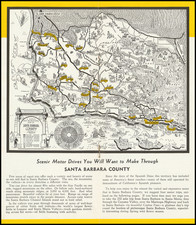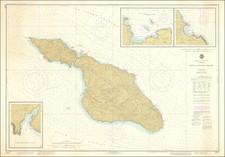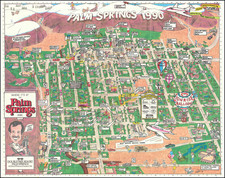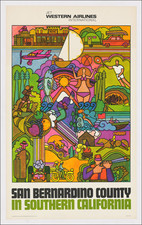The Thomas Brothers 1942 map of Stockton, California presents a detailed layout of the city during the early 20th century. It showcases various landmarks, streets, residential areas, and public places, all meticulously depicted to guide residents and visitors alike. On the verso, the map extends to cover the broader San Joaquin County, reflecting the interconnectedness of Stockton to the surrounding towns and countryside.
Stockton, located at the head of a navigable channel, several miles east of the San Joaquin River and approximately 90 miles inland from San Francisco Bay, has always been a significant place due to its location. Its importance as a transportation hub, as illustrated on the map, further increased when the Port of Stockton was opened to deep sea traffic in 1933.
Between 1900 and 1950, Stockton underwent substantial changes. The early 20th century saw the city's population swell due to its central location in the agricultural-rich Central Valley, making it a hub for commerce. In the 1920s, the city continued to grow as a commercial and transportation center, with new roads and highways being built. The city's infrastructure expanded during this period, with new public buildings, parks, and schools constructed to accommodate the growing population.
The 1930s were marked by the Great Depression, which undoubtedly affected Stockton, yet the opening of the Port of Stockton provided a lifeline, stimulating economic activity. Stockton was then further affected by World War II. The establishment of the Stockton Naval Communications Annex and the Stockton Ordnance Depot brought an influx of military personnel and their families, leading to a spike in the city's population.
Despite the challenges, the mid-century period also saw significant progress. Stockton State Hospital, an expansive mental health facility, was converted into the Stockton branch of the University of the Pacific in 1951, leading to an uptick in the city's intellectual and cultural life.
The Thomas Brothers 1942 map provides a window into the city's layout and its relationship with the broader San Joaquin County during this pivotal period in Stockton's history. It offers a glimpse into a city in transition, capturing the essence of Stockton as it was transforming into an essential hub in California's burgeoning 20th-century economy.
Thomas Brothers and Their Legacy in Mapping
The Thomas Brothers, pioneering cartographers of the 20th century, carved a unique niche in the world of mapmaking with their meticulous street atlases that have since become indispensable resources for countless Americans. The trio's journey began in the bustling hub of Oakland, California, in 1915, where George Coupland Thomas and his two brothers established Thomas Bros. Maps.
Initially, their publications included detailed block maps, birds-eye views of communities, and what one might consider generalized tourist maps. Their emphasis on accuracy, granularity, and user-friendliness quickly set them apart in the growing map industry. By the late 1940s, the brothers expanded their offerings, introducing street guides initially available as pocket-sized booklets. These guides encapsulated regions across several counties in California and even extended to Washington, offering detailed street views and points of interest.
A significant historical footnote is the company's involvement in producing redlining maps for several major Californian cities like Los Angeles, San Francisco, and Sacramento for the US government-sponsored Home Owners' Loan Corporation in the 1930s. These maps, controversial in today's context, played a role in shaping urban development and housing policies of the time.
In 1940, seeking larger opportunities and driven by the company's burgeoning success, the Thomas Brothers relocated their headquarters to Los Angeles. The move coincided with the addition of pocket-sized guidebooks dedicated to California and San Francisco, complete with fold-out maps, further solidifying their dominance in the local market.
Following the death of George Coupland Thomas in 1955, the company witnessed a transition in leadership. Warren B. Wilson, the family lawyer, acquired the business. Under his guidance, Thomas Bros. Maps continued to flourish, adapting to the changing needs of the market and expanding its geographic footprint.
By the onset of the California home development boom in the 1970s, the company's reputation was unparalleled. The transition to Irvine, California, in 1980 under Wilson's directive marked a new era, with the company setting its sights on digital innovations and new markets.












![[ San Jose ] Map of the City of San Jose Published By Geo. H. Hare Dealer in Books and Stationery San Jose, 1872 (bound with Hare's Guide To San Jose and Vicinity For Tourists and New Settlers . . . )](https://storage.googleapis.com/raremaps/img/small/48098.jpg)



![[ Stockton ] Map of the Waterfront of the City of Stockton Showing Proposed Improvements in the Alignment of the Waterfront and Adjacent Street and Property Lines Drawn For The City Council By H.T. Compton. City Surveyor. February 1899](https://storage.googleapis.com/raremaps/img/small/83468.jpg)